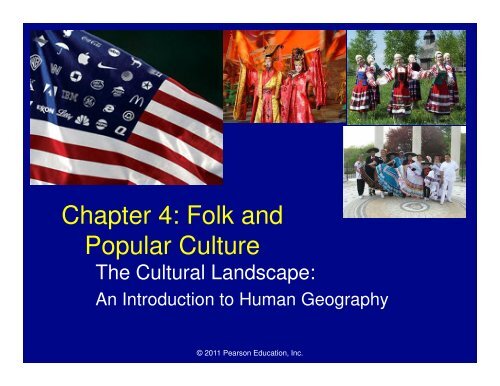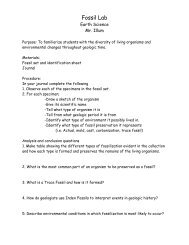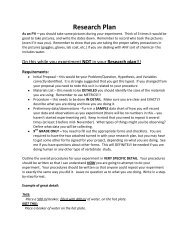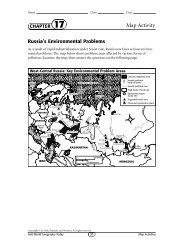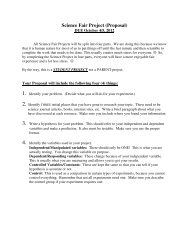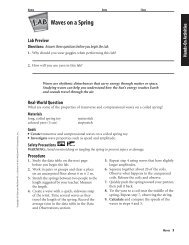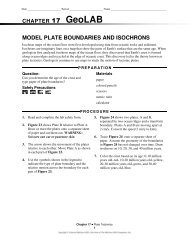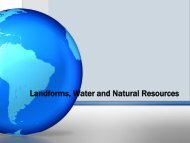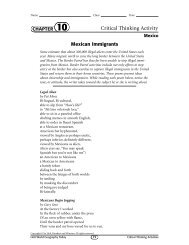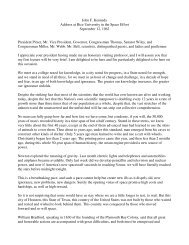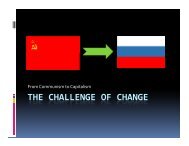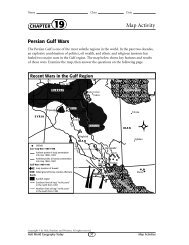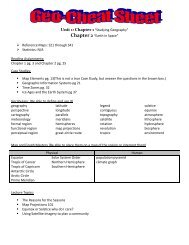Chapter 4 Folk and Popular Culture Lecture - legacyjr.net
Chapter 4 Folk and Popular Culture Lecture - legacyjr.net
Chapter 4 Folk and Popular Culture Lecture - legacyjr.net
Create successful ePaper yourself
Turn your PDF publications into a flip-book with our unique Google optimized e-Paper software.
<strong>Chapter</strong> 4: <strong>Folk</strong> <strong>and</strong><strong>Popular</strong> <strong>Culture</strong>The Cultural L<strong>and</strong>scape:An Introduction to Human Geography© 2011 Pearson Education, Inc.
<strong>Culture</strong>• The combination of three things:– Values– Material artifacts– Political institutions• This chapter deals with material artifacts© 2011 Pearson Education, Inc.
Material <strong>Culture</strong>• Two basic categories: folk <strong>and</strong> popularculture– <strong>Folk</strong> culture• Traditionally practiced by small, isolated, homogeneousgroups in rural areas– <strong>Popular</strong> culture• Characterized by large, heterogeneous groups of peoplewho share common habits despite differences in otherpersonal characteristics– Geographers are interested in two aspects ofculture:• Where cultures are located in space• How cultures interact with the environment© 2011 Pearson Education, Inc.
Where Do <strong>Culture</strong>s Originate <strong>and</strong> Diffuse?• Origin of folk <strong>and</strong> popular cultures– <strong>Folk</strong> culture = hearth area; originators are usuallyunknown– <strong>Popular</strong> culture = hearth area comes from moredeveloped countries (MDCs)• People in MDCs have disposable income <strong>and</strong> leisuretime that allow for these innovations© 2011 Pearson Education, Inc.
<strong>Popular</strong> Music MapFigure 4-2© 2011 Pearson Education, Inc.
Where Do <strong>Culture</strong>s Originate <strong>and</strong> Diffuse?• Diffusion of folk <strong>and</strong> popular culture– <strong>Folk</strong> culture diffuses slowly, primarilythrough migration, <strong>and</strong> at a small scale• Example: Diffusion of Amish culture– <strong>Popular</strong> culture diffuses rapidly, viahierarchical diffusion, <strong>and</strong> over a largescale• Example: Sports© 2011 Pearson Education, Inc.
Distribution of AmishThe movement of theAmish is based upon theconcept of h<strong>and</strong>ing downa farm to each of thesons. As farm l<strong>and</strong> getsmore expensive inPennsylvania, the Amishare moving to where l<strong>and</strong>is cheaper, thusspreading Amish culture.Figure 4-4© 2011 Pearson Education, Inc.
Iroquois LacrosseThe story of the Iroquois Nation ( a group of six Native Americantribes) playing as a Nation equal in status with Canada or theU.S. in LacrosseFigureis4-5an example of a minority or <strong>Folk</strong> group findingacceptance or at least equality on the sports field.© 2011 Pearson Education, Inc.
Why Is <strong>Folk</strong> <strong>Culture</strong> Clustered?• Influence of the physical environment– <strong>Folk</strong> culture = close connection to theenvironment• Most folk cultures are rural <strong>and</strong> agricultural– Clothing is often tied to environmental conditions» Example: Wooden clogs in the Netherl<strong>and</strong>s• <strong>Folk</strong> cultures can ignore environmentalconditions© 2011 Pearson Education, Inc.Designed to keep theirexpensive leather shoes outof the mud <strong>and</strong> muck.
Why Is <strong>Folk</strong> <strong>Culture</strong> Clustered?• Influence of the physicalenvironment– Food preferences <strong>and</strong> theenvironment• Food preferences are adapted to theenvironment– Example: In Asia, rice is grown in milder,wetter environments whereas wheat isgrown in colder, drier environments• Food taboos may be especially strong– People avoid certain foods because ofnegative associations with that food• Terroir = the sum effects of the localenvironment on a particular food item© 2011 Pearson Education, Inc.
Istanbul Vegetable GardenWhat particular part of thediet is this illustration ofIstanbul, Turkey show is ofparticular concern?Figure 4-6© 2011 Pearson Education, Inc.
Swine StockHalf of the World’sSwine Stock are inChina!Figure 4-8© 2011 Pearson Education, Inc.
Why Is <strong>Folk</strong> <strong>Culture</strong> Clustered?• Influence of the physicalenvironment– <strong>Folk</strong> housing <strong>and</strong> theenvironment• Housing = a reflection of culturalheritage, current fashion, function,<strong>and</strong> the physical environment• Two most common buildingmaterials = wood <strong>and</strong> brick• Minor differences in theenvironment can produce verydifferent house styles© 2011 Pearson Education, Inc.
House Types in Four WesternChinese CommunitiesEach housing type is influencedby cultural as well asenvironmental conditions.Figure 4-9© 2011 Pearson Education, Inc.
Why Is <strong>Folk</strong> <strong>Culture</strong> Clustered?• Isolation promotescultural diversity– Examples:• Himalayan art• Beliefs <strong>and</strong> folk house forms– Sacred spaces– U.S. folk housing© 2011 Pearson Education, Inc.
Hearths of House TypesFigure 4-12© 2011 Pearson Education, Inc.
Why Is <strong>Popular</strong> <strong>Culture</strong> Widely Distributed?40’s60’s50’s70’s• Diffusion of popular housing,clothing, <strong>and</strong> food– <strong>Popular</strong> culture varies more intime than place• Food customs: consumption oflarge quantities of snack foods<strong>and</strong> alcohol• Clothing styles: reflectoccupation rather thanenvironment• Housing: reflects fashion trendssince the 1940s in the UnitedStates© 2011 Pearson Education, Inc.
Canadian WhiskyConsumption of CanadianWhiskey <strong>and</strong> TequilaMexican TequilaFigure 4-14© 2011 Pearson Education, Inc.
U.S. House Types (1945–1990)Figure 4-16© 2011 Pearson Education, Inc.
Why Is <strong>Popular</strong> <strong>Culture</strong> Widely Distributed?• Electronic diffusion ofpopular culture– Watching television• The most popular leisureactivity in MDCs• Diffusion from the United Statesto the rest of the world = 50years– The Inter<strong>net</strong>• Diffusion from the United Statesto the rest of the world = 10years© 2011 Pearson Education, Inc.
Diffusion of TVFigure 4-18© 2011 Pearson Education, Inc.
Diffusion of FacebookFigure 4-21© 2011 Pearson Education, Inc.
Why Does <strong>Popular</strong> <strong>Culture</strong> CauseProblems?• Threats to folk culture– Loss of traditional values– Media imperialism– Satellites• Limit to government control of information© 2011 Pearson Education, Inc.
Why Does <strong>Popular</strong> <strong>Culture</strong> CauseProblems?• Environmental impact of popular culture– Modifying nature• Golf courses• Uniform l<strong>and</strong>scapes– Negative impacts• Increased dem<strong>and</strong> for natural resources• Pollution© 2011 Pearson Education, Inc.
Golf CoursesFigure 4-24© 2011 Pearson Education, Inc.
The End.Up next: Language© 2011 Pearson Education, Inc.


